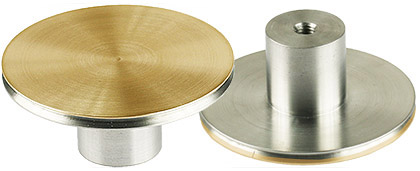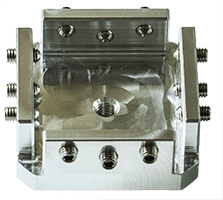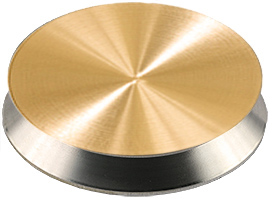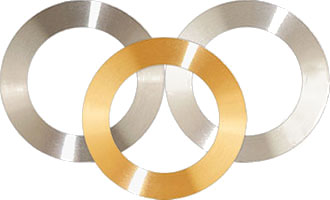
EM-Tec Sputter Targets for Sputter Coaters
Carbon fiber threads for carbon evaporation
EM-Tec Quartz Crystals for Thickness monitors
EM-Tec Disc or Annular Sputter Targets for EM Sputter Coaters
High Quality, High Purity Sputter Targets
Introduction
The high purity EM-Tec sputter targets are compatible with a
wide variety of desk top sputter coaters. The sputter coaters are used
to sputter a very thin layer of conductive metal on non-conductive
sample in order to investigate these samples with a scanning electron
microscope (SEM). The EM-Tec sputter targets are compatible with the
following sputter coaters, ion beam coaters or cryo-SEM preparation
systems brands: Agar, Anatech/Technics, Bal-Tec, Bio-Rad, Cressington,
Denton, Edwards, Emitech, EMS, Emscope, Fisons, Gatan, Hitachi, Hummer,
ISI, JEOL, Leica, Polaron, Quorum, Safematic, SPI, Thermo and VG
Microtech. Targets are relatively expensive due to the high purity of
the precious metals which require multiple refining steps. A purity of
99.99% or close is desired to avoid any artefacts either in imaging or
with EDX analysis. The target material you are using because it is
installed in the sputter coater might not be best choice and there are
alternatives for many applications. Depending on your application, there
is a choice of coating materials, see section: Practical information selecting target material to coat SEM Samples.

EM-Tec sputter targets on target holder substrate
for sputter coaters: Emscope/ Bio-Rad /
Thermo VG sputter coater SC500 / SC500A
EM-Tec Disc Type Sputter Targets
The EM-Tec disc type sputter targets are made using high
purity metal foils and are available in 62, 60, 58, 57, 54, 50, 24 and
19mm diameter. Disc type sputter targets are widely used is all brands
of sputter coaters. Most modern sputter coaters use a clamping ring to
hold the target. Some older systems use a target support plate where the
target needs to be bonded with the target plate by using silver paint
or Indium.
Use the EM-Tec Disc Sputter Target Selection Table to
determine the target size for your coater (alternatively measure the
target in your sputter coater) or go directly to ordering information
for the target size:
- Ø62mm disc type high purity EM-Tec sputter targets for Hitachi sputter coaters
- Ø60mm disc type high purity EM-Tec sputter targets for sputter coaters
- Ø57mm disc type high purity EM-Tec sputter targets for sputter coaters
- Ø54mm disc type high purity EM-Tec sputter targets for sputter coaters
- Ø50mm disc type high purity EM-Tec sputter targets for sputter coaters
- Ø28mm disc type high purity EM-Tec sputter targets for Cresisngton 208HRD sputter coaters
- Ø24mm disc type high purity EM-Tec sputter targets for cryo-SEM preparation systems
- Ø19mm disc type high purity EM-Tec sputter targets for Gatan ion beam sputter coaters
- Ø60mm high purity EM-Tec sputter targets on target holder for Emitech and EMS sputter coaters
- Ø58mm high purity EM-Tec sputter targets on target holder for Emscope SC500 / SC500A sputter coaters
EM-Tec Annular Type Sputter Targets
Annular sputter targets are less common than the disc type
sputter targets. They are used on the older Polaron sputter coaters and
on the Anatech/Technics Hummer sputter coaters. For the annular
targets, the target material is attached to an aluminum support ring
and they are supplied as complete assemblies. Available as targets with
pure gold, gold/palladium, platinum, platinum/palladium, silver,
copper and nickel. There are two sizes offered:
- Ø82mm OD x Ø60mm ID annular type high purity EM-Tec sputter targets for sputter coaters
- Ø3inch OD x Ø2inch ID annular type high purity EM-Tec sputter targets for sputter coaters
Determine the target size
Two Sputter Target Selection Tables ( one for dics type and one for annular type) can be used to determine the target size for your sputter coater (alternatively measure the target in your sputter coater).
EM-Tec Disc Type Sputter Target Selection Table
Manufacturer |
Models |
Ø62mm |
Ø60mm |
Ø58mm |
Ø57mm |
Ø54mm |
Ø50mm |
Ø28mm |
Ø24mm |
Ø19mm |
Agar |
Manual / Automatic |
|
X |
|
|
|
|
|
||
Agar |
High resolution sputter coater |
|
X |
|
|
|
|
|
||
Anatech/Technics |
Hummer I / II / III / Jr |
|
|
|
X |
|
|
|
||
Bal-Tec |
SCD 005 / 040 / 050 / 500 |
|
|
X |
|
|
|
|
||
Bal-Tec |
MED 10 / MED 20 |
|
|
X |
|
|
|
|
||
Bio-Rad |
SC5200 / SC502 |
|
X |
|
|
|
|
|
||
| Bio-Rad | E7400 / LT7400 | X |
|
|||||||
| COXEM | SPT-20 | X |
|
|||||||
Cressington |
108manual / 108auto |
|
X |
|
|
|
|
|
||
Cressington |
108auto/SE |
|
X |
|
|
|
|
|
||
Cressington |
208HR |
|
X |
|
|
|
|
|
||
Cressington |
208HRD |
|
|
|
|
X |
|
|
||
Denton |
Desk II / II / IV / V |
X |
|
|
|
|
|
|
||
Edwards |
150B / Scancoat |
X |
|
|
|
|
|
|
||
Emitech |
SC7620 / SC7610 |
|
X |
|
|
|
|
|
||
Emitech on Ø60mm target holder |
K500X / K550X / K650X |
X |
|
|
|
|
|
|
||
Emitech |
K575X &XD / K675X & XD |
|
X |
|
|
|
|
|
||
Emitech |
Q150 |
|
X |
|
|
|
|
|
||
EMS |
150R / 150T / 300R / 300R |
|
X |
|
|
|
|
|
||
EMS |
K575X &XD / K675X & XD |
|
X |
|
|
|
|
|
||
EMS |
SC7620 / SC7610 |
|
X |
|
|
|
|
|
||
EMS on Ø60mm target holder |
K500X / K550X / K650X |
X |
|
|
|
|
|
|
||
Emscope on Ø58mm target holder |
SC500 / SC500A |
|
X |
|
|
|
|
|
|
|
Emscope |
SC502 |
|
X |
|
|
|
|
|
||
Fullam |
EffaCoater / EMS-76 |
|
|
|
X |
|
|
|
||
Gatan |
681 Ion Beam Coater |
|
|
|
|
|
|
X |
||
Gatan |
682 PECS Ion Beam Coater |
|
|
|
|
|
|
X |
||
Gatan |
685 PECS II Ion Beam Coater |
|
|
|
|
|
|
X |
||
GSEM |
G10 / G20 |
|
|
|
X |
|
|
|||
Hitachi |
MC 1000 |
X |
|
|
|
|
|
|
|
|
HHV |
BT150 / BT300 |
|
|
X |
|
|
|
|||
HoYeon |
HC21 |
|
X |
|
|
|
|
|
||
ISI |
ISI 5400 |
|
X |
|
|
|
|
|
||
JEOL |
JFC-1200 / 1300 / 1400 / 1600 |
|
X |
|
|
|
|
|
||
JEOL |
JFC-2300HR |
|
X |
|
|
|
|
|
||
Leica |
EM SCD 005 / 050 / 500 |
|
|
X |
|
|
|
|
||
Leica |
EM MED 020 |
|
|
X |
|
|
|
|
||
Leica |
ACE 200 / ACE 600 |
|
|
X |
|
|
|
|
||
Pelco |
SC4 / SC5 / SC6 / SC7 |
|
X |
|
|
|
|
|
||
Polaron / Bio-Rad |
E5000 / E5200 / E5400 / E5800 |
|
X |
|
|
|
|
|
||
Polaron / Bio-Rad |
PS 3 |
|
X |
|
|
|
|
|
||
Polaron / Quorum |
SC7620 / SC7610 |
|
X |
|
|
|
|
|
||
Quorum |
Q150R / Q150T / SC7620 / MiniQS |
|
X |
|
|
|
|
|
||
Quorum |
Q300R / Q300T |
|
X |
|
|
|
|
|
||
| Quorum | PP2000 / PP2000T |
|
X | |||||||
| Quorum | PP3000T / PP3010T |
|
X | |||||||
| Safematic | CCU-010 | X |
|
|||||||
SEC |
MCM-100 / MCM-200 |
|
|
|
X |
|
|
|
||
SPI |
SPI-Module |
|
X |
|
|
|
|
|
||
SPI |
SPI Super |
|
|
|
X |
|
|
|
||
| VG Microtech / Fisons / Thermo | PP2200 / PP2000T |
|
X |
EM-Tec Annular Type Sputter Target Selection Table
Manufacturer |
Models |
82mm O.D. X 60mm I.D. |
3” O.D. X 2” I.D. |
Anatech / Technics |
Hummer V / VI / 6.2 / 8 |
|
X |
Polaron / Biorad |
E5100 / E5150 / E5175 / SC510 / SC515 |
X |
|
Polaron / Quorum |
SC7640 / SC 7680 |
X |
|
Ordering Information EM-Tec Disc Targets
|
|||||||||||||||||||||||||||||||||||||||||||||||||||||||
|
|||||||||||||||||||||||||||||||||||||||||||||||||||||||||||||||||||||||||||||||||||||
|
|||||||||||||||||||||||||||||||||||||
|
|||||||||||||||||||||||||||||||||||||||||||||||||||||||||||||||||||||||||||||||||||||||||||||||||||||||||||||||||||||||||||||||
|
|||||||||||||||||||||||||||||||||||||||||||||||||||||||||||||||||||||||||||||||||||||||||||||||||||||||||||||||||||||||||||||||||||||||||||||||||||||||||||||||||||||||||||||||||||||||||||||||||||||||||||||||||||||||||||||||||||||||||||||||||||||||
|
|||||||||||||||||||||||||||||||||||||||||||||||||||||||||||||||||||||||||||||||||||||||||||||||||||||||||||||||||||||||||||||||||||||||||||||||||||||||||||||||||||||||||||||||||||||||||||||||||||||||||||||||||||||||||||||||||||||||||||||||||
|
|||||||||||||||||||||||||||||||||||||||||||||||||||||||||||||||||||||||||||||||||||||||||||||||||||||||
|
|||||||||||||||||||||||||||||||||||||||||||||||||||||||||||||||||||||||||||||||||||||||||||||||||||||||||||||||||||||||||||||||||||||||||||||||||||||||||||||||||||||||||||||||
|
|||||||||||||||||||||||||||||||||||||||||||
|
|||||||||||||||||||||||||||||||||||||||||||||||||||||||||||||||||||||||||||||||||||||||||||||||||||||||
|
|||||||||||||||||||||||||||||||||||||||||||||||||||||||||||||||||||||||||||||||||||||||||||
|
|||||||||||||||||||||||||||||||||||||||||||
Practical Information on Selecting a Target Material to coat SEM Samples
Selection of the optimum coating material depends on the
(non-conductive) sample, the application and cost. Most SEM sputter
coaters allow for a relatively easy target change. When using different
coating (target) materials than Gold, the use of Argon as process gas
is paramount. One should be aware that each sample material behaves
differently when coated. The coating quality is obviously affected by
the target material and by the interaction of the sample material and
metal used for the coating. Coating the SEM sample with a (highly
conductive) metal makes non-conductive SEM samples conductive. An
additional benefit is that most coating materials have a higher
secondary electron (SE) yield than the non conductive sample material.
Coating material with lower atomic numbers is more suitable for for
backscattered electron (imaging) whereas coating with higher atomic
numbers is more suitable for SE imaging. Below you will find some
pratical guidance information for selecting the target material. The
information is only valid when using modern DC magnetron SEM sputter
coaters and Argon as process gas.
If EDX analysis of the sample is needed, always choose a
coating (target) material which is not present in the sample, creates
overlapping peaks in the EDX spectrum or otherwise interferes with the
EDX analysis.
Gold
Gold is an excellent and most widely used coating material to coat non-conductive samples for standard SEM applications. Due to the low work function it is a very efficient to coat and when using cool sputter coaters and thin layers, there is hardly any heating of the sample surface. The grain size is visible when using high magnifications on modern SEMs. Gold can be used for table top SEMs with air as process gas.
Gold/Palladium
The Au/Pd alloy (60/40) is less efficient to coat than with pure gold, which results in lower sputter rates. Au/Pd is often recommended to achieve a smaller grain size. Au/Pd gives smaller grain sizes when evaporated in high vacuum, but when used in SEM sputter coaters the difference between Au and Au/Pd is hardly visible. Less suitable for heat sensitive specimens and less suitable for EDX analysis due to the extra set of peaks for Pd.
Silver
Ag is a most suitable and low cost alternative for Au in many
imaging applications for low and medium magnifications ranges. It is a
widely underestimated coating material. Ag has the highest conductivity
of all metals. When using EDS, Ag is an alternative for Au on many
biological samples if P, Cl and S need to be analyzed. Sputtering rate
is similar to Au, the SE yield is somewhat lower than for Pt, Au or Ir.
The grain sizes is similar or slightly larger than Au, except for
samples containing halogens which can cause coarser grains. The Ag
coating can tarnish (in the presence of halogens) and are less suitable
for long term storage. Excellent low cost coating material for many
less demanding imaging applications and table top SEMs.
An additional advantage is that the Ag coating can be dissolved
and the sample surface can be studied in the original conditions.
Removal of Au, Au/Pd, Pt and Ir coatings is more difficult and involves
very harsh chemicals. The Ag coating can be removed with Farmer's
reducer (Mixture of Potassium Ferricyanide and Sodium Thiosulfate).
Platinum
Pt has a finer grain size than Au or Au/Pd and is therefore more suitable for higher magnifications. Excellent SE yield. The higher work function results in slower sputtering than Au. Pt tends to be sensitive for “stress cracking” when oxygen is present (oxygen can come from porous samples). More expensive than Au due to higher fabrication costs.
Platinum/Palladium
Pt/Pd alloy (80/20) has a similar grain size and SE yield as pure Pt, but is less senstive to “stress cracking”. Suitable all-round coating material for FESEM applications when thin coatings are used. Best results are achieved when using high resolution sputter coaters
Iridium
Iridium exhibits a very fine grain size on virtually all materials and is an excellent all-round fine grain coating material for FESEM applications. It is the material of choice for high and ultra-high resolution FESEM imaging. With the added benefit of being a non-oxidising material and a high SE yield, it is replacing Chromium for high resolution sample coating. It requires the use of a high resolution sputter coater and has lower sputtering rates. The targets are thicker due to fabricated constraints, but overall costs are lower than for Pt or Pt/Pd. Ir is also an excellent alternative material for coating samples which have to be analyzed for carbon by EDX or WDX. A thin layer is enough to creat excellent conductivity and since the material is very rare it hardly interferes with EDX or WDX analysis.
Chromium
Cr has a very fine grain size, especially on semiconductor type
materials and has proven to be a useful coating materials for FESEM
applications. Cr requires the use of a turbo pumped, high vacuum, high
resolution sputter coater with a target shutter since the presence of
oxygen (as in standard SEM coaters) causes oxidisation during coating.
The Cr on the sample surface will oxidise in air and samples must be
viewed immediately after coating. Samples can be stored in high vacuum
or in inert gas. Cr has lower sputtering rates and the target tends to
heat up. Lower SE yield than Pt, Pt/Pd or Ir. Excellent coating
material for high resolution BE imaging of low Z and biological
samples.
Tungsten
W is an excellent alternative for ultra-high resolution
coating. W has a very fine grain size and tends to be less visible than
Cr. W oxidises rapidly, similar to Cr. Low sputtering rates, but due to
the high atomic number the SE yield tends to be higher. Samples must
be imaged immediately after coating or stored under high vacuum.
Tantalum
Ta is also a candidate for high resolution coating (most
refractory and high melting materials exhibit fine grain size). It
oxidises quite rapidly, similar to Cr. Low sputtering rates, but due to
high atomic number the SE yield tends to be higher. Samples must be
imaged immediately after coating or stored under high vacuum.
Palladium
Pd can be used as a lower cost alternative for low to medium
magnification ranges. Gives a lower SE signal than Au. When using EDX
analysis, Pd can be an alternative.
Nickel
Ni is an alternative coating material for EDX applications and
BSE imaging. Not ideal for SE imaging, the coating oxidises slowly. It
has a low sputtering rate due to the low work function and the fact that
as a magnetic materials it "short circuits" the magnet in the DC
magnetron sputter head with a less dense plasma as a result. In a
standard SEM sputter coater, the coating contains a mixture of Ni and
Ni-oxide. The Ni coating layer can enhance elements through X-ray
fluorescence. If needed, the Ni coating can be removed with a
Hydrochloric acid or Nitric acid.
Copper
Cu is an alternative low cost material for EDX applications
and BSE imaging. Suitable for low and medium magnification ranges. Lower
SE yield. Coatings will slowly oxidize. In a standard SEM coater the
coating consists of a mixture of Cu and Cu-oxide. However, it is a low
cost alternative for educational applications to demonstrate and to
investigate the influence of coating parameters. The Cu coating layer
can be used to enhance the analysis of transition materials through
X-ray fluorescence. If needed, the copper coating can be removed with
Ferric Chloride or Nitric Acid.
ITO - Indium Tin Oxide
ITO targets consist of In2O3 / SnO2 with a 90/10 wt%
composition. ITO is an interesting material since it is electrically
conductive and light transparent. One application for SEM is
Cathodeluminescence imaging and/or analyzing of non-conductive samples
with a detector/spectrometer. ITO is also useful for coating glass
coverslips for correlative microscopy applications.
Titanium
Ti is seldom used as coating material, but has applications
where it is chosen to avoid any interference with EDX analysis. Low
atomic number gives less interference with BSE imaging. Ti oxidises
quite rapidly and samples need to be imaged directly after coating.
Carbon
Carbon is the material of choice for coating non-conductive
samples to allow for EDX analysis and BE imaging. It is has a low
atomic number, is conductive and is inert at room temperature. It can't
be sputtered in DC magnetron sputter coaters; high energy is needed and
if sputtered it tends to deposit as DLC material which is
non-conductive. Carbon can be used as a target in ion-beam coaters such
as the Gatan models 681, 682 and 685. Otherwise it is used in carbon
evaporaters to coat SEM samples or to produce carbon support films for
TEM.
Cobalt
Cobalt is not generally used for SEM coating applications. It
has a (very) low sputtering rate due to the low work function and the
fact that as a magnetic materials it "short circuits" the magnet in the
DC magnetron sputter head with a less dense plasma as a result. In a
standard SEM coater, the coating contains a mixture of Co and Co-oxide.
The Co coating layer can enhance elements through X-ray fluorescence.
Indium
Indium is not generally used for SEM coating applications. It
has a (very) low sputtering rate due to the low work function. In a
standard SEM coater, the coating contains a mixture of In and In-oxide.
The In coating layer can enhance elements through X-ray fluorescence
Tin
Tin is not generally used for SEM coating applications. It has a
(very) low sputtering rate due to the low work function. In a standard
SEM coater, the coating contains a mixture of Sn and Sn-oxide. The Sn
coating layer can enhance elements through X-ray fluorescence.
Zinc
Zinc is not generally used for SEM coating applications. It has
a (very) low sputtering rate due to the low work function. In a
standard SEM coater, the coating contains a mixture of Zn and Zn-oxide.
The Zn coating layer can enhance elements through X-ray fluorescence.
Magnesium
Magnesium is not generally used for SEM coating
applications. It has a (very) low sputtering rate due to the low work
function. In a standard SEM coater, the coating contains a mixture of Mg
and Mg-oxide. The Mg coating layer can enhance elements through X-ray
fluorescence. Magnesium is a flammable material; be careful when
handling.
Lead
Lead is not generally used for SEM coating applications. It
has a (very) low sputtering rate due to the low work function. In a
standard SEM coater, the coating contains a mixture of Pb and Pb-oxide.
The Pb coating layer can enhance elements through X-ray fluorescence.












